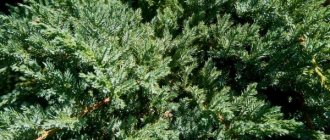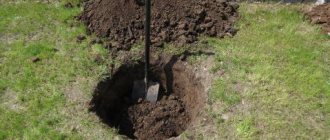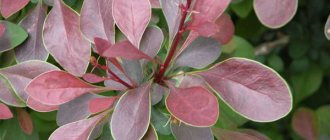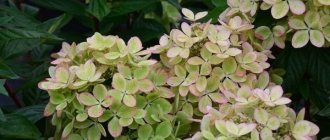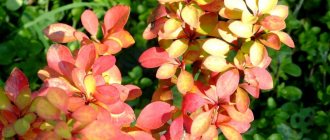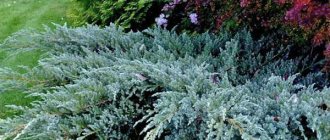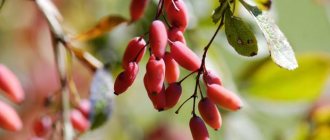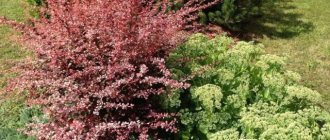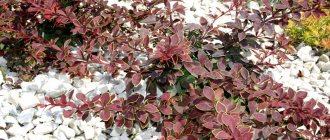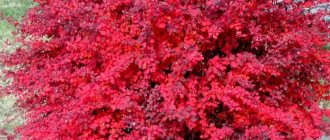Description of barberry Green Carpet
Barberry thunberg Green Carpet is a deciduous, slow-growing shrub. Its height reaches 1 meter, diameter - 1.5 meters. The crown of the plant is spreading and slightly flattened. The leaves are light green in summer and turn orange-yellow in autumn. Yellow inside and red outside inflorescences are located along the entire length of the branches. Flowering occurs at the end of May.
Barberry thunberga Green Carpet
The red fruits ripen in September and remain on the plant after the leaves fall off.
Attention! With good care, the planting can decorate the site with its appearance for 50 years.
Description
A small shrub with a round fluffy top, reaching a height of 1 meter in an adult plant. The top of the plant is from 15 centimeters to one and a half meters in circumference with small bright green leaves, located often on the branch, close to each other and creating a fairly dense and dense crown.
The flowers are two-colored, red on the outside, yellow on the inside, collected in inflorescences that have a flat, round shape. They begin to bloom in late May or early June.
The leaves of the Green Carpet baarberry are green in spring and summer, yellow and red with the arrival of autumn and retaining their bright colors until winter
Frost-resistant, drought-resistant, light-loving plant. It can grow on any soil, as it is not very demanding on these conditions.
The crown is formed spreading, hanging and fluffy due to the constant annual growth of shoots, which reach 10 centimeters. Has thorns
The oblong-shaped fruits ripen in early September. Numerous pink and red, shiny, smooth fruits are poisonous, unsuitable for consumption and are only a decorative addition to the brightly flowering shrub.
The fruits that have not fallen in autumn are partially retained on the bush throughout the winter, which gives the bush its attractiveness during this period of the year.
Planting a plant
Barberry bush - types, varieties, planting and care
Barberry bushes are planted on the site in spring or autumn. Choose a place that is sunny and not blown by north winds.
The culture prefers to grow on slightly alkaline soils. If the soil is acidic, lime or dolomite flour is first added to it.
Planting from seeds
In the fall, the site is cleared of debris, dug up, and the soil is loosened.
Planting seeds is done as follows:
- make grooves 1-3 centimeters deep;
- water the beds;
- seeds are sown densely;
- covered with sand, then insulated with sawdust.
Barberry seeds have poor germination, so they need to be sown thickly. Germination will occur in the spring, after the onset of warm days. If necessary, seedlings are thinned out. Bushes can be planted in a permanent place after 1.5-2 years.
Planting seedlings in open ground
Young plants are planted on the site as follows:
Planting barberry as a hedge
- Dig holes with a depth and diameter of 40 centimeters. If several bushes are planted, the distance between them is left at least 2 meters.
- A drainage of small stones or expanded clay is laid at the bottom, then a layer of fertile soil is poured.
- The seedlings are placed in the middle of the ditch, the roots are straightened, and they are covered with earth.
- The tree trunk circle is compacted and watered.
Important! If a gardener plans to plant barberry as a hedge between plots, the interval between bushes should be no more than 50 centimeters.
Barberry thunberg Green Ornament
Barberry thunberg Green Ornament.
Dense rounded shrub up to 1.5 m high and wide. The branches are vertical, prickly, covered with small rounded leaves, up to 3 cm long, when blooming they are bronze-green then dark green, and in autumn they turn reddish-yellow. The flowers are yellow, reddish on the outside, solitary or collected in bunches of 2-5, appear in May and are located throughout the shoot. Prefers a sunny location. It is not picky about soils and can grow in soils of any acidity. Prefers fresh, drained substrates. Does not tolerate waterlogging. Resistant to drought and city conditions. Good haircut.
Planting barberry: If you plant bushes individually, then the distance between them should be from 150 to 200 cm. If such a bush is used to create a hedge, then no more than 2 bushes are planted per 1 linear meter. Planting holes must be prepared 14–20 days before planting. The size of such a pit should be 40x40 cm, while the depth of the trench for the hedge is 0.4 m. To improve the aeration of the root system, the bottom of the pit should be filled with a layer of sand.
Care: Barberry thunberg Green Ornament (Green Ornament) is extremely unpretentious and undemanding in care. Caring for all barberries consists of watering, pruning, loosening the soil, removing weeds and timely feeding. If the summer period is characterized by long dry periods, then watering should be done once every 7 days, using cool water, which should be poured directly under the root, trying to ensure that the liquid does not end up on the surface of the leaf plates.
Soil for planting: Regarding the acidity of the soil, barberry prefers neutral soils, but it can normally withstand soil with a pH no higher than 7. If the soil on the site is strongly shifted to the acidic side, it needs to be limed.
Preparation for winter : Young specimens that are not yet 5 years old should be covered with spruce branches for the winter, especially if the species is evergreen. The branches must be tied tightly with twine (rope), after which a kind of cylinder made of metal mesh is built around the bush, and its height should exceed the bush by 10 centimeters. The existing voids inside the constructed structure must be filled with dry fallen leaves, and then the cylinder itself must be wrapped with covering material.
Place for planting: Due to the unpretentiousness of barberry thunberg Green Ornament , it can grow in open areas, since it is not afraid of drafts and strong winds, as well as in partial shade, but under the bright sun, varieties and species with purple leaves look brighter.
Reproduction: The plant must be at least 3–5 years old, and its root collar must be at a depth of at least 10 centimeters. In spring, the bush needs to be dug up, and then it is divided into several sections, which should be approximately the same in size. In order to divide the root itself, you may need not only pruning shears, but also a garden saw. Proceed with extreme caution, trying to cause as little damage to the plant as possible. When the bush is divided, all sections must be smeared with crushed charcoal, after which the sections are planted in open ground. In the case when the stems of a specimen begin to branch above the ground surface, this propagation method is not used.
The Gardens of Eden online store will help make your dreams of creating the perfect garden come true. We will be useful for professional and novice gardeners, for collectors of rare varieties, for landscape designers, for communities of joint purchases. We work directly with the largest and most time-tested manufacturers of planting material, from all over Europe and Russia. And we offer for sale without intermediaries seedlings of ornamental perennial plants, shrubs, trees, conifers, as well as fruit and berry and bulbous plants. We also have our own production of perennial plants, which we grow for you with love and care. All plants are adapted to the Russian climate. Our assortment includes thousands of different varieties, as well as exclusives and new items. We carefully select only the best offers, eliminating unscrupulous manufacturers with possible mis-grading. Carefully designed packaging allows plants to be delivered in excellent condition even to the far corners of the country. We love our customers, therefore we take a very responsible approach to the issue of the quality of planting material, and are also responsible for the work of the Russian Post and transport companies.
How to care for Green Carpet barberry
Bushes require care, which includes watering, fertilizing, loosening the soil, and removing weeds. To maintain a decorative appearance, pruning is done twice a season.
- Watering
Barberry Bagatelle - description, planting and care
The variety is drought-resistant and does not require frequent watering. But the bushes become most decorative with regular irrigation.
If the weather is dry, hot, water the barberry at least once a week. The soil should be moistened to a depth of at least 40 centimeters. Use warm, settled water for irrigation.
- Top dressing
They begin to fertilize the bushes 2-3 years after planting.
In spring, nitrogen fertilizers are used to increase the vegetative mass.
At the beginning of summer, barberry is fed with full mineral fertilizer.
In August, potassium and phosphorus are added under the bushes.
Important! To prevent the root system from being burned by salts, the soil is first moistened with plain water before any fertilizing.
- Trimming
To make the shrub look decorative, pruning is done in early summer, then in early autumn.
The shoots are cut to ⅓ of their length. In addition, dry, wind-damaged, diseased branches are removed during the season. The procedure is carried out with a sharp, disinfected instrument. The work is carried out with gloves, since the shoots have sharp thorns.
- Flowering period
Depending on the region of growth, Green Carpet barberry blooms at the end of May or at the very beginning of June.
Inflorescences consist of 2-5 flowers dispersed over the entire surface of the shoot. They are painted red. Small fruits ripen from the inflorescences by autumn.
Barberry fruits
Growing and care
Barberry Green Carpet can grow and develop in almost any conditions. But still, for planting, it is recommended to choose sunny areas that are well protected from drafts.
To play it safe, it is better to purchase ready-made seedlings from a trusted nursery. These can be young plants with an open or closed root system.
A few hours before planting, barberries in tubs are watered abundantly to facilitate the removal of the earthen clod from the walls of the container.
The soil on the site should be neutral. For good growth of Green Carpet barberry, alkaline or acidic soil is suitable.
A week before planting, the holes are prepared. To create a hedge, they are dug at a distance of 0.5 m. If it is assumed that the shrubs will grow singly, they are spaced 2 m apart from each other. A convenient hole size is 25 by 25 cm; for adult plants older than three years, these parameters are increased up to 40 cm.
Planting takes place in April. To cover the root system, a soil mixture is first prepared: superphosphate, sand, humus, soil. A drainage layer of crushed stone is laid at the bottom of the hole.
The seedling is placed in a hole, the root shoots are straightened, covered with prepared soil mixture, and lightly compacted. After planting, pour a bucket of water under each plant.
Barberry Green Carpet is watered in spring and summer, no more than once a week. Each plant needs approximately two buckets of water. The rest of the time, Green Carpet barberry receives enough moisture from precipitation.
After watering, the soil is loosened. It can then be covered under a layer of peat mulch.
First year plants are not fertilized. They have enough nutrients that were added during planting. After the first flowering, barberry is fed with mixtures containing potassium and phosphorus. Then the bush is fertilized in late autumn.
From the second year, the Green Carpet bush can be shaped by pruning. Also, after winter, dry parts of the plant are removed. At the end of summer, the branches are thinned out. Pruning is carried out from the bottom up: the shoots are shortened by half with pruning shears.
Despite the high levels of winter hardiness, in the first years after planting, Green Carpet barberry may suffer from snowless, frosty winters. During this period, it is recommended to cover it with a spruce forest.
Reproduction methods
There are several ways to grow a plant of the genus Berberis on your site. Most often, cuttings and propagation by layering are used. When the bushes grow, they can be divided and planted separately. Gardeners usually do not use seed propagation because it is labor-intensive, and the bushes are ready for planting on the site only after 2 years.
Barberry Maria - description and cultivation
Reproduction by layering is carried out in the spring as follows:
- dig a groove 8-10 centimeters deep;
- bend the branch to the ground;
- secured with bent wire;
- the place of contact is covered with soil;
- watered.
Throughout the summer, the cuttings are looked after: watered, loosened, and the grass growing around is removed. In the fall, the young seedling formed at the pinning site is transplanted to a permanent place.
Using cuttings, sections of shoots are first rooted in water, or immediately planted in boxes with light soil. When the cuttings begin to grow, they are first transplanted into separate containers, then onto the plot.
Additional information: barberry berries are dried and used as a seasoning for pilaf. The aroma is better preserved in whole fruits.
Reproduction
There are several ways to propagate Green Carpet barberry. They are all quite simple and convenient. To choose the right one, you should familiarize yourself with them in more detail:
- Using seeds. Ripe berries are collected, the seeds are removed from them, they are disinfected in a low concentration solution of potassium permanganate and dried. The prepared seeds are planted to a depth of 10 mm in a temporary bed, and in April the sprouts sprout, leaving a distance of 3-4 cm between them. When the seedlings reach 2 years, they are transplanted to a permanent place. It is also possible to plant seeds in spring; in this case, they must be kept in wet sand or coconut substrate for 2-3 months at a temperature of + 2-5 °C.
- Using cuttings. Preparations for breeding begin in early summer. The foliage is removed from the cuttings, leaving only a little at the very top. After this, the cuttings are placed in a container with root solution for several hours to stimulate the development of the root system. The prepared material is planted on a temporary bed. During the first weeks it is very important to ensure that the soil is sufficiently moist. After 2 years, young bushes can be transplanted to a permanent place.
- Using layering. At the beginning of spring, the strongest shoot is selected and placed in a specially prepared groove no more than 10 cm deep, securing it in this position. In this case, the end of the shoot should be above ground level. The area where roots will form can be scratched a little to speed up the process. In the fall, the resulting seedling is transplanted to the planned location.
- By dividing the bush. This method is well suited for low-growing varieties such as Green Carpet. Bushes aged 3-6 years are suitable for propagation. In April, the bushes are completely removed from the ground and, being careful not to damage the root system, are carefully separated into parts using a garden hacksaw. It is recommended to treat the sections with a weak solution of potassium permanganate or charcoal. Parts of the bush are planted in a new place.
Diseases and pests
Barberry thunberga variety Green Carpet may be attacked by aphids and moths. The first one sucks juices from leaves and shoots in a short time, the second one eats the berries.
Approved insecticides are used against pests. Gardeners who prefer to use folk remedies can spray the bushes with a solution of soap or tobacco. However, experienced barberry owners say that traditional methods help only at the initial stage of the attack.
Among the diseases, barberry can be affected by powdery mildew and leaf spot. Fungicides are used to combat pathogenic microorganisms. To prevent disease, bushes can be sprayed several times with copper-containing preparations for prevention.
Use in landscape design
Barberry Green Carpet is so good that it can be used in the garden as a tapeworm. A single planted bush will decorate the area with green leaves in summer, and yellow-orange leaves in autumn. Barberry will look no less impressive in a shrub mixborder. You need to select plants that are different in height, shape, and leaf color.
Green Carpet can also be planted in a group of 3-5 shrubs. For example, a pyramidal thuja is planted in the center of the landscape composition, and barberry is planted around it. The group is planted in the central part of the site and it becomes visible from all sides. You can build a hedge from the crop by trimming it from the sides and leaving the top free.
Using the Green Carpet variety in the landscape
History of selection
Green Carpet belongs to the Barberry family, one of the 50 Thunberg varieties. The latter was cultivated in its homeland in Japan, where it grows freely in the wild. During an experiment in Holland in 1965, Green Carpet barberry was obtained from it. Thanks to the efforts of specialists, the crop is resistant to negative environmental influences: drought, frost, air pollution. The Green Carpet shrub can be cultivated in the garden for 50 years; it has good annual growth (about 10 cm).
Medicinal properties
All parts of the plant are used as medicine. Barberry contains alkaloids, tannins, organic acids, vitamins, and microelements.
The plant has the following medicinal properties:
- heals wounds;
- blocks inflammatory processes;
- treats diseases of the stomach and intestines;
- removes toxins;
- calms the nervous system;
- helps in the treatment of diabetes;
- strengthens the walls of blood vessels.
Note! Before you start treatment with barberry yourself, using folk recipes, you should definitely consult with your doctor.
Barberry is also included in cosmetics: shampoos, creams, soaps, scrubs, masks. Many products with the addition of the plant can be prepared independently. Thus, when growing a beautiful planting on a personal plot, a gardener will be able not only to admire the spectacular shrub, but also to use all its parts to improve the health of the body.

